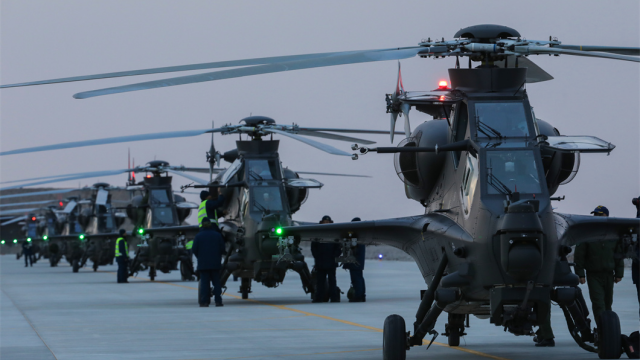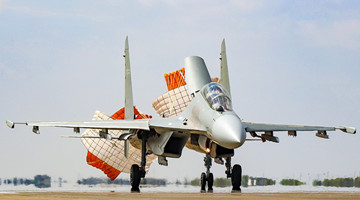
By Dai Xunxun
Recently, Russian President Vladimir Putin signed anexecutive order, formally titled “Basic Principles of State Policy of the Russian Federation on Nuclear Deterrence.”The document proclaims the principles for the use of nuclear weaponsby the Russian Federation. While increasing military transparency, the document also shows Russia's tough stanceonnuclear deterrence.
The policy document now also offers a detailed description of situations that could trigger the use of nuclear weapons. Situations include: a) the arrival of reliable data on launch of ballistic missiles attacking the territory of the Russian Federation and/or its allies; b) the use of nuclear weapons or other types of weapons of mass destruction by an adversary against the Russian Federation and/or its allies; c) the attack by adversary against critical governmental or military sites of the Russian Federation, disruption of which would undermine nuclear forces response actions; d) the aggression against the Russian Federation with the use of conventional weapons when the very existence of the state is in jeopardy, with the latter two new.
Accordingly, Russia can resort to nuclear weapons or launch nuclear counterattacks when hit by nuclear weapons or even when having determined that its critical targets, including the transportation system, energy system, and communication system, are disrupted. The move will lower the threshold for the use of nuclear weapons. Russian experts believed that such clarification is intended to issue a warning to the US and other Western countries, clearly delineating the "red line" of Russia's strategy, so as to calm down the heated minds of NATO leaders.
In the past, almost all Russian nuclear policies were indirectly reflected in its documents likemilitary doctrines and national security concepts. This separate publication showsRussia's strong stanceon nuclear deterrenceand certainly has something to do with the US containment policy towards Russia in recent years.
Under the "America first" concept, the "withdrawal from various agreements" has become the norm for the US. In the field of international arms control, the US withdrew from the Intermediate-Range Nuclear Forces (INF)Treaty and then announced its exitfrom theTreaty on Open Skies. Besides, the US has also been indifferent to the renewal of the US-Russia New Strategic Arms Reduction Treaty (New START), having lifting the threshold on purpose to delay the negotiation. The US itself has constantly been lowering the nuclear threshold, allowing the use of intercontinental ballistic missiles as conventional weapons to strike other countries, no longer regarding the use of low-yield nuclear warheads as nuclear war, and promoting miniaturized and tactical nuclear weapons. Not long ago, the US threatened to resume nuclear testing.
In the real geopolitical game, the UShas also continued to strengthen its military deployment in areas surrounding Russia, including sending troops to each of the three Baltic states and Poland, installing the land-fixed Aegis Ashore in Romania, and making the presence of US troops in Ukraine a norm on the pretext of the worsening situation in Ukraine. These moves have greatly reduced Russia's strategic buffer zones while enhancing the US'capacities against Russia in early warning and strikes.
At the same time, the US has been frequently carried out targeted military provocations against Russia, such as dispatching B-1B strategic bombers into the Sea of Okhotsk, which is surrounded on three sides by Russian territory, sending naval formations into the Barents Seaoff Russia's Arctic coast, and conducting close-range reconnaissance on Russianmilitary bases in Syria. All these moves are sure to increase the possibilities of head-on conflicts between Russia and the US.
Facing the aggressive actions of the US, Russia is naturally reluctant to swallow the insult. Russia has always regarded nuclear weapons as its ultimate deterrent. In this newly-released policy document, Russiahas declared a strong attitude and shown a firm position to defend national security through the use of nuclear weapons. The document also serves as a strong response and warning to the US: Russia will not hesitate to "prepare for the worst" to defend its national security and the interests of its allies.
However, Russia's move is not a desperate gamble, and there are strategic considerations of "pretending to move ahead to keep a route of retreat" behind it.
The US-Russia arms control mechanism faces a crisis of complete dismantling, which has left Russia overwrought. On the one hand, arms control is currently one of the few areas where Russia can negotiate with the US on an equal basis. A bilateral arms control mechanismmeans that the two countries should shoulder special "responsibilities as great powers" for the world. This is an excellent platform for Russia to demonstrate its status as a great power. On the other hand, the mechanism is an important guarantee for maintaining the strategic stability of both sides, a way to avoid the US and Russia from entering the abyss of nuclear war, and meanwhileto protect Russia from the drag of nuclear arms race.
Although the Russian side intends to do its utmost to bring the US back to the negotiating table and "cool down" tensions, the US' attempts to "smash" the existing systems and establish anew US-led arms control system have been all too clearand hard to change course. The promulgation of a new version of the nuclear deterrent policy by the Russian Federation seems to escalate the tension. Still, its underlying meaning is to force the US into carefully examining its policies toward Russia, and restraining its dangerous actions against Russia, thereby reducing the risk of Russia-US conflicts, especially nuclear wars, and safeguarding Russian national security to the maximum.
(The author is with the Warfare Research Institute of PLA Academy of Military Science)









